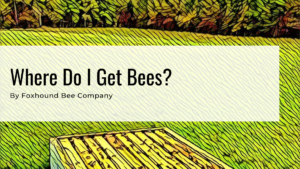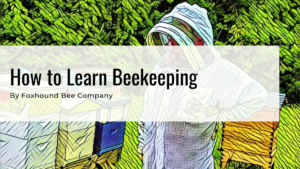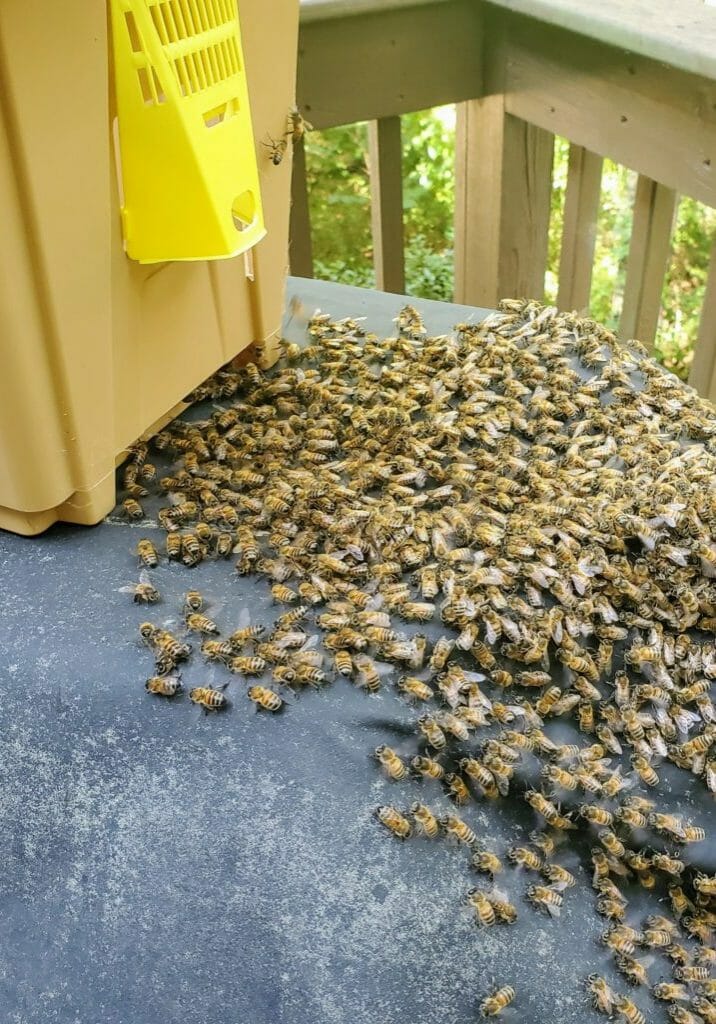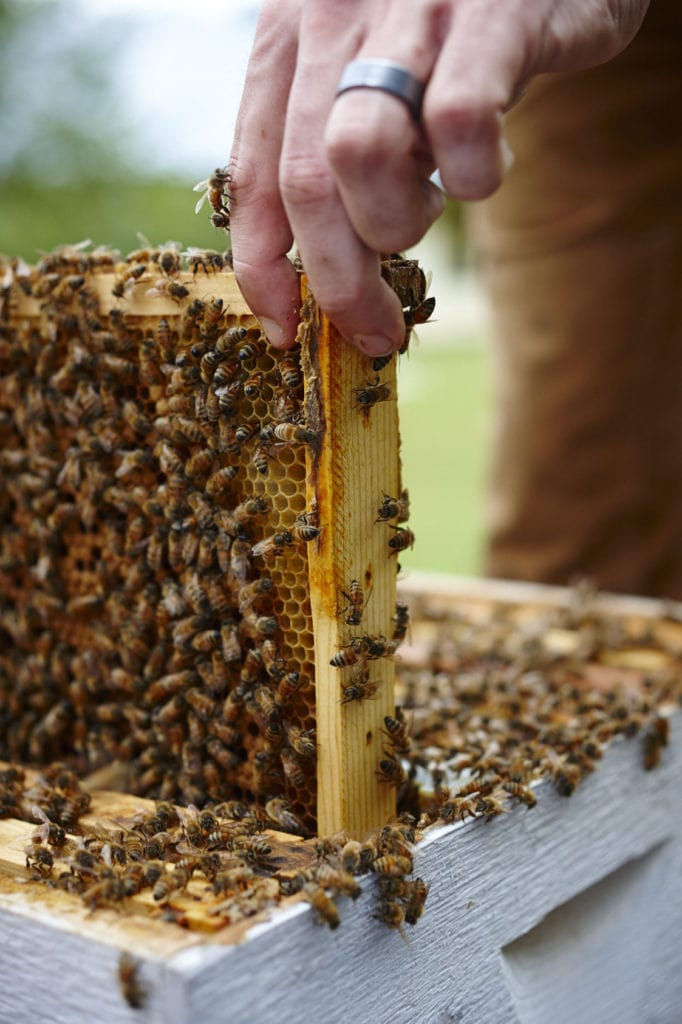Taking care of honeybees is a very challenging and rewarding hobby that impacts more than just yourself. Honeybees contribute to our environment in a positive way and have a direct impact locally.
Your neighbors may not realize it, but a beehive placed in your neighborhood will make a positive change in their yards.
Unfortunately, many beekeepers who start a hive will stop taking care of bees within 2 or 3 years. This is due to a variety of reasons, but the vast majority of beekeepers who quit do so because they didn’t realize what is involved.
It’s better to take a little bit of time to learn what is involved with beekeeping in order to find out if beekeeping is right for you. It certainly isn’t for everyone, but if it is for you, you’ll love it!
Table of Contents
Bees Aren't Bluebirds
When we teach classes, we like to make the analogy about birds and bees. Not that analogy… we tell students that taking care of bees isn’t like taking care of birds.
With birds, you can just put out a birdhouse in a place that they like, and they will take care of themselves. Sometimes the birds will be there; sometimes they won’t, but they will be ok.
Bees, on the other hand, can’t be placed in a box and left to take care of themselves. Honey bees are really great at taking care of themselves day-to-day, but throughout the course of the year, their demands change.
Sometimes they need more room to grow, and sometimes they need less room. The beekeeper’s responsibility is to manage the bees through the seasons, making sure they have the resources they need, including food when necessary, a queen, the proper entrance size, etc…

Let’s say, for example, you want to take care of a hive or two in your backyard, no big deal. You aren’t in it for the honey, you just think it’s cool and want to help the environment.
A noble reason. You buy some bees, a hive, watch some YouTube videos, and now you have a couple of honey bee colonies doing their thing day in and day out.
Honey isn’t really your thing, so you aren’t concerned about adding additional honey boxes because you aren’t going to harvest it.
This is great until the population of bees quadruples during the spring (like it does every year) and the colony swarms onto the swing set in your neighbor’s yard.
They hang out there for a couple of days and then move off. But then it happens again. Or maybe the swarm of bees starts building a new colony in the soffit of a nearby house.
Beekeepers want to avoid these types of situations for many reasons, but primarily because you want to be a good neighbor. If the hives were out in the country, this wouldn’t be a big deal.
But through good management techniques taught in beginner classes, you’ll be able to reduce the chance of this ever happening.
More Than Honey
One of the best parts of beekeeping is that it covers a wide variety of topics, topics that can typically appeal to everyone. Woodworking, nature, engineering, sweat-equity, food, working with your hands, geometry, danger, bugs, homesteading, working alone, astronomy, a little “cowboying” (not a word), meteorology, and many more appealing parts of beekeeping.
If you are the type of person that likes to explore and really dive deep into a topic, then beekeeping is for you. Beekeeping is one of those hobbies that you can engulf yourself in it and pursue a wide variety of fields, all beekeeping-related. It’s not just about honey.
Science in Beekeeping
Beekeeping is definitely a science and there are researchers who spend their entire careers studying a single aspect of how honey bees work.
You don’t need to have been an AP Bio genius to be a good beekeeper, but if you enjoy a little of the why behind the what, then beekeeping may be for you.
It is really fascinating to understand how you can create a situation inside a beehive and predict how a colony of bees is going to react to it.
For example, if you want to turn one colony into two, you can take some bees, eggs, honey, and pollen (but not the old queen) and move them into a new box right next to the old one.
The new box will panic and start raising its own queen from an egg within a few hours. It’s incredible that they can do this and fascinating that you can create a situation for them to do it.

Art in Beekeeping
The bees operate according to sciences, and even though they are incredible at making comb and collecting pollen into a mosaic of colors, they aren’t really artists. The art of beekeeping is more about the beekeeper than the bees. Being able to read your colony of bees is a learned skill and makes beekeeping easier.
This may seem strange to the average person because they just seem like a bunch of bugs. However, it doesn’t take long for beekeepers to learn the different personalities of their colonies. Some colonies are a little meaner than others.
Taking care of a colony of bees over months helps beekeepers to learn this art. Beekeepers will learn how to slowly open a hive so as to not disrupt them and how the sound of their buzz changes as they grow tired of being messed with. Lighting a bee smoker and using it correctly with your bees is definitely a learned skill.

Master Guide – Beekeeping For Beginners
Table of Contents Starting a beehive and taking care of it is a lot of fun. From unpacking your new beekeeping suit to pouring (yes,

Master Guide – Is Beekeeping Right For Me?
Is beekeeping right for me?: Part 2 of 5 in our ultimate guide to getting started in beekeeping. Find out if you are the type

Master Guide – What Beekeeping Equipment Do I Need?
Figuring out beekeeping equipment is the most intimidating part of getting started in beekeeping. There are a lot of options, designs, and equipment configurations to

Master Guide – Where Do I Get Bees?
From our experience of getting new beekeepers started, no part of the beginning is harder than finding bees. Sometimes beginner beekeepers strike gold and get

Master Guide – How To Learn Beekeeping?
Learning to become a beekeeper is a rewarding and challenging experience. There are a lot of ways to learn how to keep bees, and we
The Dark Side Of Beekeeping
When talking with beginners, we like to shoot straight with them and set their expectations appropriately. The first year of beekeeping is the toughest, both for the bees and the beekeeper. The beekeeper is learning a new hobby that is more like farming; it’s a hobby that is active every day of the year. Beekeepers do not have to do something daily or even weekly, but the bees are always working.
Colonies don’t always make it. In our Beekeeping for Beginners post, I wrote about how this is the worst part of beekeeping. It’s discouraging to walk up to a hive you thought was doing really well only to find out something has killed them. There are probably a half dozen common causes for a hive to die; some are obvious, some are not. It’s disappointing to feel like you are doing everything right, and it still doesn’t work out. That is part of beekeeping, unfortunately.
This chart shows the average losses over the winter for backyard beekeepers. A loss is a colony that has died. You can see what the average has been over the years.
It fluctuates each year, but around 4 out of 10 hives don’t survive the year. Beekeepers who quit after a year or two don’t expect this to happen. They get so discouraged by it and feel like they are doing a poor job.
There are definitely some good practices to minimize colony deaths, but it is normal in our modern beekeeping. The way that beekeepers deal with this is by crying.
Not really. They keep more than one hive so that the chances of going down to zero hives are very low. The sweet spot is about 5 or 6 hives, but at least two. We aren’t getting into it here, but it’s straightforward to turn one colony into two or three each year. Therefore, if you have two hives and one dies, you can turn the surviving colony into two.
Maybe this isn’t the best way to encourage people to get into beekeeping, but as a company, we focus on education and want students to be as prepared as they can be to take care of bees. Lying to them about how easy it is isn’t what we do.
The good news is it gets much easier after the 1st and 2nd years. Not because the bees are better, but because the beekeeper is better.
How Much Time Does Beekeeping Take?
The amount of time necessary to be a successful backyard beekeeper will vary depending on where you live and how many hives you have. For most parts of the country, the winter drops daily temperatures below 50°F for several months of the year. During these months, the bees do not fly, and their populations are very low. This is the offseason for beekeepers, and there isn’t that much to do with the actual bees. Most of the time spent “on bee stuff” during the winter is like reading, making plans for next year, etc…
During the spring and summer, however, there is much to do. We compare it to gardening and feel like it is a pretty good analogy. There is actually a little more weekly work to do in taking care of a garden than a beehive. During the spring and summer, gardens have grown quickly, and there are some weekly and monthly tasks to do like watering, pulling weeds, and harvesting. As summer fades, these chores start to taper off and there isn’t much to do.

Bees follow this same pattern and their activities match the seasons. Every spring the bees want to do the same thing, forage for food, build comb, and swarm.
Every fall they want the same thing, reduce the population size and get ready for winter. In the big picture, you see that there are more responsibilities during the warm months and less during the winter.
How much time then does it really take? During the warm months, it is good to check in on the colony every 1-2 weeks for a first or 2nd-year beekeeper. Closer to 2 weeks is better than weekly, and it’s not recommended to open the hive daily.
Typical tasks when visiting the hives are refilling sugar syrup jars, checking on the queens progress, and adjusting frames. Sometimes you only need 5 minutes to refill the sugar syrup and make sure the bees are still there.
Other times you’ll spend about 20 minutes a hive looking through frames. So every 7-14 days, you might spend 2 hours doing some beekeeping activities with 2 hives. Beekeepers tend to spend more than that, however, because it’s fun.
Hives Are Heavy
You might think, what do muscles have to do with taking care of bees. Everyone knows that bees are incredibly industrious and work day in and day out. As a result of this, they can store a lot of honey inside their colony.
The honey is very heavy for how much room it actually takes up in the hive. Because of this, the beekeeping equipment can be cumbersome. Almost too heavy at times.
Some hives have become popular as alternatives to the standard Langstroth hive most beekeepers use (the white boxes stacked on each other). These other hives are horizontally designed, so a beekeeper never has to lift a heavy box.
The part that requires some oomph is when you keep bees in a traditional Langstroth hive, and it has 4 boxes stacked up. To get to the 3rd box, the 4th box needs to be removed. These boxes, when full of honey, can we 40lbs+. It’s not so much it’s impossible, but it is something to consider.
Worried about the weight, consider 8 frame medium beekeeping kits, a top bar hive, or a horizontal Langstroth hive. All are great options.

Critical Thinking Is Key To Beekeeping

I remember walking into a beekeeping meeting for our local club for the first time in 2012, not having any idea of what I was getting into. Turns out, I loved it and now run our business Foxhound Bee Company full time now.
One of the first takeaways from that meeting is that beekeepers have an opinion (shocker right). It seems that every beekeeper does things differently. They all have their own way of doing things and that way is the best way.
It wasn’t until about a year later that I realized everyone has their own perspectives because beekeepers have their own goals and abilities. The beekeeper who doesn’t care about honey is going to manage their hives differently than the beekeeper who wants to get every last drop of honey they can from their bees.
Similarly, the beekeeper who is retired and has a workshop is going to build their own custom feeder that works great for them. If you don’t know a hammer from a nail, however, you aren’t going to use that type of feeder because you aren’t going to build it.
You are going to use a feeder that is best for you, one you can just buy. The same goes for the beekeeper who can lift 100lbs without even thinking about it. They are going to use different equipment than the one who has a bad back or can’t lift a big watermelon alone.
Do What Works For You
Beekeeping is very local and personal. Not all bee colonies operate the same way and not all beekeepers have the same motivation. What works for another beekeeper may not work for you. It’s important to be a critical thinker when working with bees. If you are a systematic person who likes to problem solve, then beekeeping is for you. If you just love nature and see the special side of bees and how important they are to us, then beekeeping is for you.
We ran a poll on our Facebook page asking our followers, “What kind of person makes a good beekeeper?”. By far the most popular submission was something related to critical thinking and being able to observe. I’ve said it from the 1st year I started taking care of bees, beekeepers are very innovative people who enjoy solving problems. Beekeepers are always seeing an issue and trying to solve it themselves. There are so many beekeeping inventions out there that are made to help with little problems, and it’s amazing to see that ingenuity in people.








